Report on Business Organisations: Types, Functions and Structures
VerifiedAdded on 2023/06/05
|7
|2144
|379
Report
AI Summary
This report provides a detailed overview of business organizations, starting with an explanation of different types such as sole proprietorships, partnerships, and limited companies, including their respective advantages and disadvantages. It then compares and contrasts tall and flat organizational structures, exemplified by companies like Tesco and Expedia. The report defines various business functions like human resources, finance, marketing, research and development, and operations, highlighting their impact on organizational performance. Finally, it discusses organizational culture, emphasizing the importance of a positive culture and its effects on employee relationships, alignment, innovation, and overall performance, with examples from companies like Google and Zoom. The document is available on Desklib, a platform offering a variety of study tools and solved assignments for students.
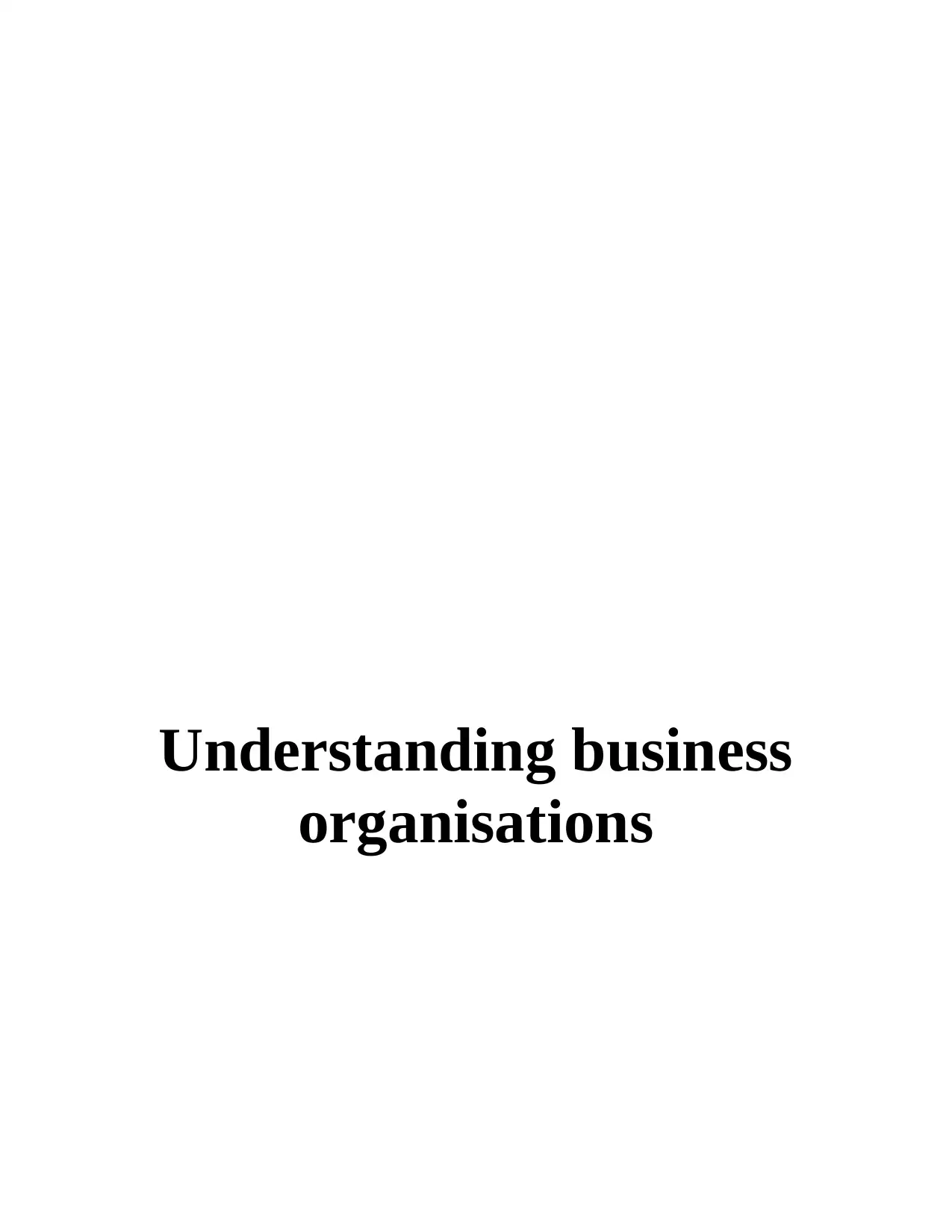
Understanding business
organisations
organisations
Paraphrase This Document
Need a fresh take? Get an instant paraphrase of this document with our AI Paraphraser
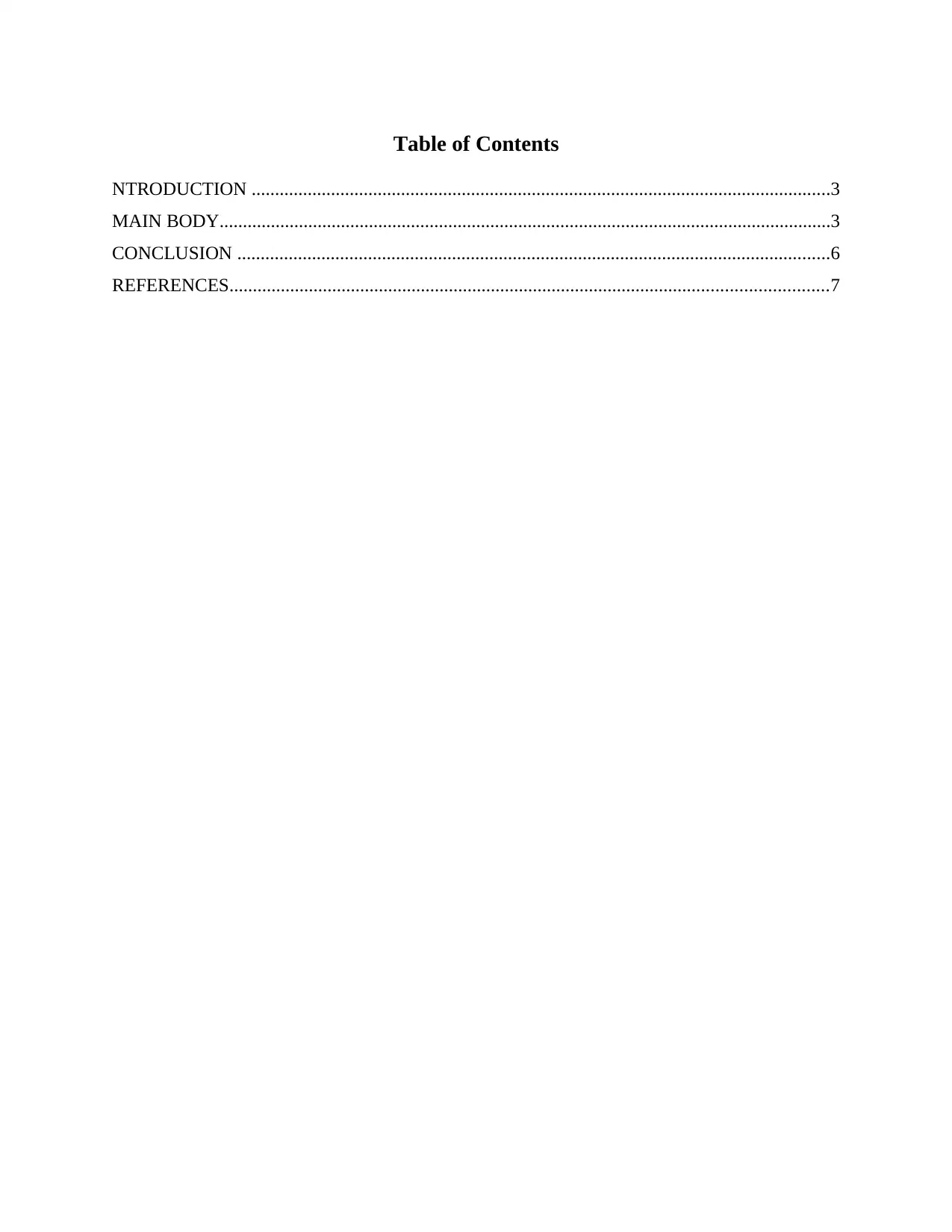
Table of Contents
NTRODUCTION ............................................................................................................................3
MAIN BODY...................................................................................................................................3
CONCLUSION ...............................................................................................................................6
REFERENCES................................................................................................................................7
NTRODUCTION ............................................................................................................................3
MAIN BODY...................................................................................................................................3
CONCLUSION ...............................................................................................................................6
REFERENCES................................................................................................................................7
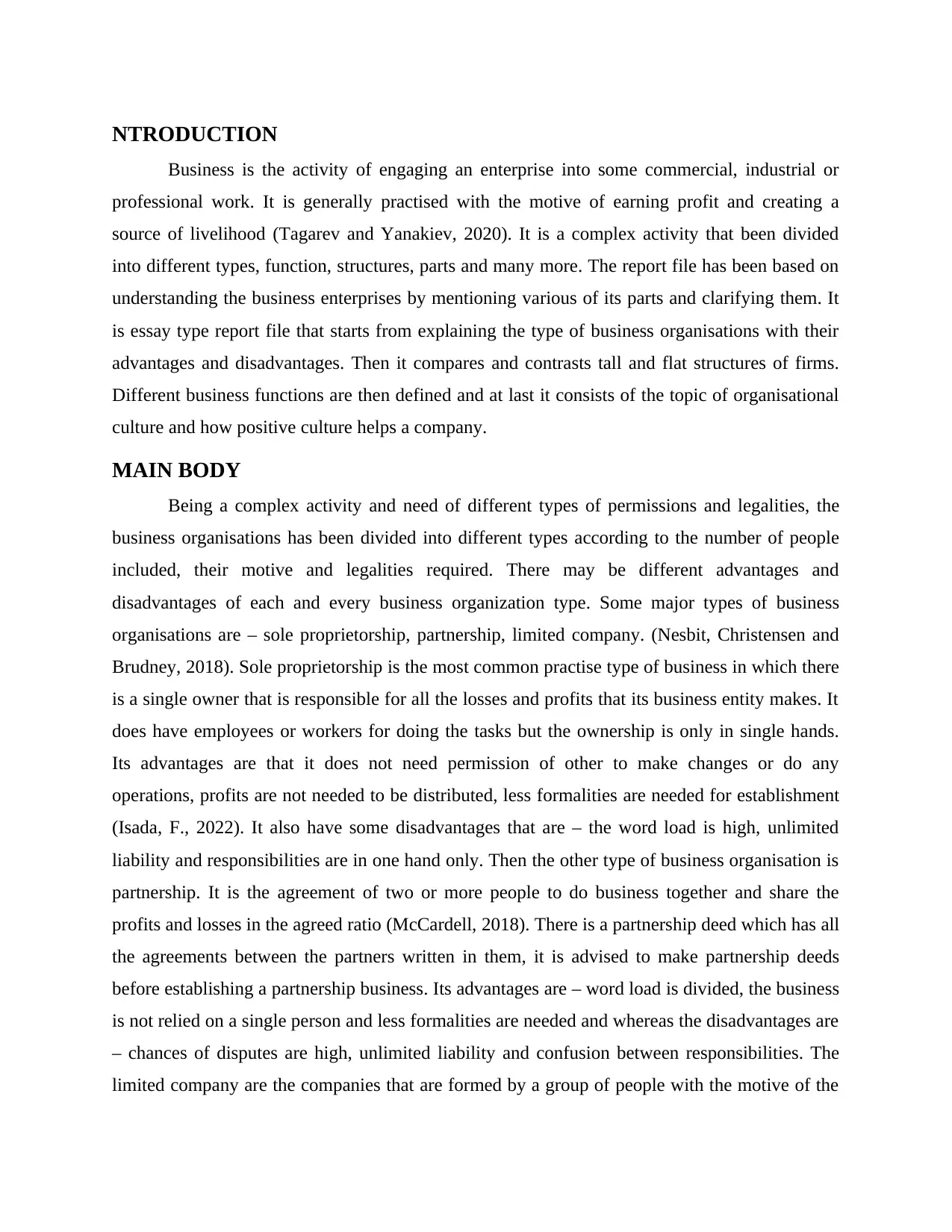
NTRODUCTION
Business is the activity of engaging an enterprise into some commercial, industrial or
professional work. It is generally practised with the motive of earning profit and creating a
source of livelihood (Tagarev and Yanakiev, 2020). It is a complex activity that been divided
into different types, function, structures, parts and many more. The report file has been based on
understanding the business enterprises by mentioning various of its parts and clarifying them. It
is essay type report file that starts from explaining the type of business organisations with their
advantages and disadvantages. Then it compares and contrasts tall and flat structures of firms.
Different business functions are then defined and at last it consists of the topic of organisational
culture and how positive culture helps a company.
MAIN BODY
Being a complex activity and need of different types of permissions and legalities, the
business organisations has been divided into different types according to the number of people
included, their motive and legalities required. There may be different advantages and
disadvantages of each and every business organization type. Some major types of business
organisations are – sole proprietorship, partnership, limited company. (Nesbit, Christensen and
Brudney, 2018). Sole proprietorship is the most common practise type of business in which there
is a single owner that is responsible for all the losses and profits that its business entity makes. It
does have employees or workers for doing the tasks but the ownership is only in single hands.
Its advantages are that it does not need permission of other to make changes or do any
operations, profits are not needed to be distributed, less formalities are needed for establishment
(Isada, F., 2022). It also have some disadvantages that are – the word load is high, unlimited
liability and responsibilities are in one hand only. Then the other type of business organisation is
partnership. It is the agreement of two or more people to do business together and share the
profits and losses in the agreed ratio (McCardell, 2018). There is a partnership deed which has all
the agreements between the partners written in them, it is advised to make partnership deeds
before establishing a partnership business. Its advantages are – word load is divided, the business
is not relied on a single person and less formalities are needed and whereas the disadvantages are
– chances of disputes are high, unlimited liability and confusion between responsibilities. The
limited company are the companies that are formed by a group of people with the motive of the
Business is the activity of engaging an enterprise into some commercial, industrial or
professional work. It is generally practised with the motive of earning profit and creating a
source of livelihood (Tagarev and Yanakiev, 2020). It is a complex activity that been divided
into different types, function, structures, parts and many more. The report file has been based on
understanding the business enterprises by mentioning various of its parts and clarifying them. It
is essay type report file that starts from explaining the type of business organisations with their
advantages and disadvantages. Then it compares and contrasts tall and flat structures of firms.
Different business functions are then defined and at last it consists of the topic of organisational
culture and how positive culture helps a company.
MAIN BODY
Being a complex activity and need of different types of permissions and legalities, the
business organisations has been divided into different types according to the number of people
included, their motive and legalities required. There may be different advantages and
disadvantages of each and every business organization type. Some major types of business
organisations are – sole proprietorship, partnership, limited company. (Nesbit, Christensen and
Brudney, 2018). Sole proprietorship is the most common practise type of business in which there
is a single owner that is responsible for all the losses and profits that its business entity makes. It
does have employees or workers for doing the tasks but the ownership is only in single hands.
Its advantages are that it does not need permission of other to make changes or do any
operations, profits are not needed to be distributed, less formalities are needed for establishment
(Isada, F., 2022). It also have some disadvantages that are – the word load is high, unlimited
liability and responsibilities are in one hand only. Then the other type of business organisation is
partnership. It is the agreement of two or more people to do business together and share the
profits and losses in the agreed ratio (McCardell, 2018). There is a partnership deed which has all
the agreements between the partners written in them, it is advised to make partnership deeds
before establishing a partnership business. Its advantages are – word load is divided, the business
is not relied on a single person and less formalities are needed and whereas the disadvantages are
– chances of disputes are high, unlimited liability and confusion between responsibilities. The
limited company are the companies that are formed by a group of people with the motive of the
⊘ This is a preview!⊘
Do you want full access?
Subscribe today to unlock all pages.

Trusted by 1+ million students worldwide
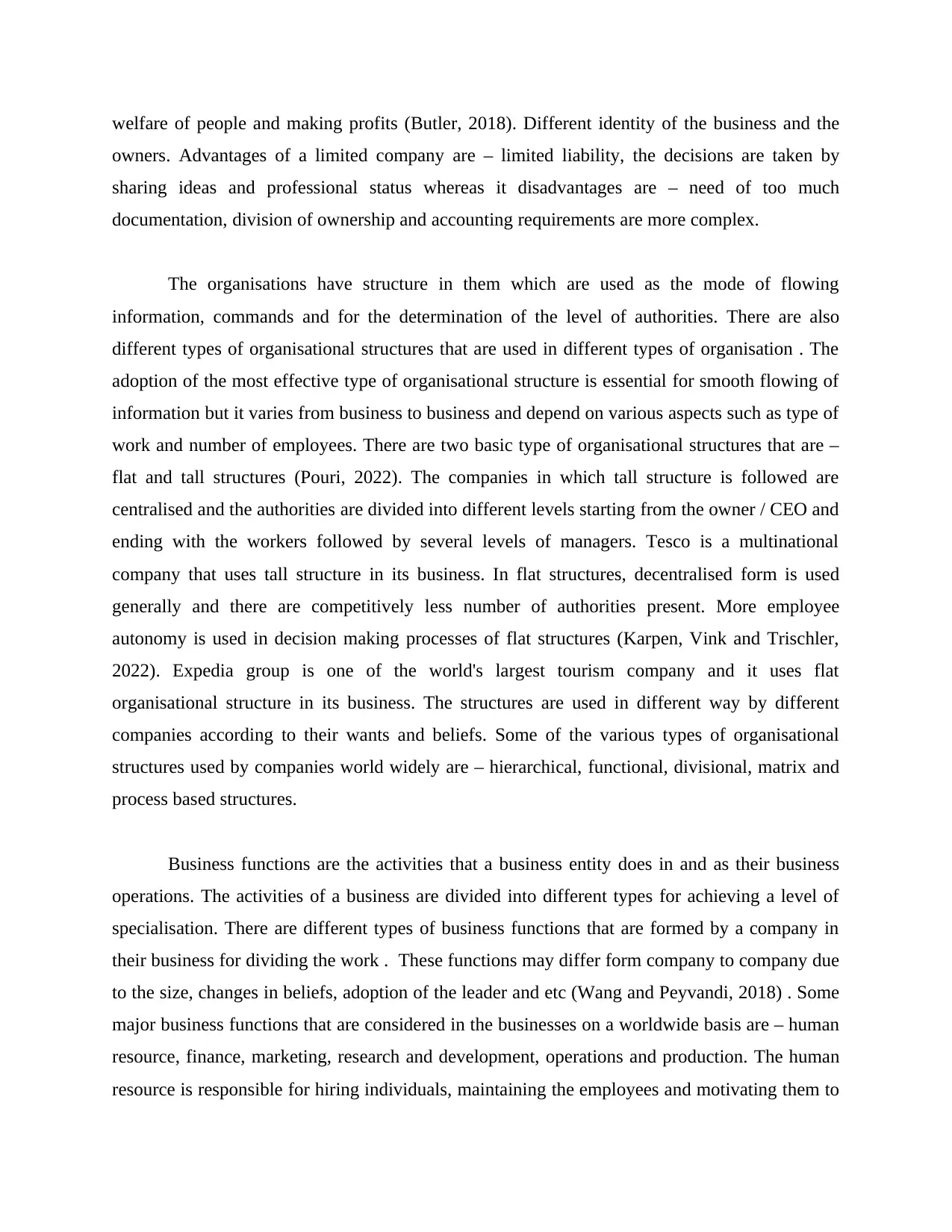
welfare of people and making profits (Butler, 2018). Different identity of the business and the
owners. Advantages of a limited company are – limited liability, the decisions are taken by
sharing ideas and professional status whereas it disadvantages are – need of too much
documentation, division of ownership and accounting requirements are more complex.
The organisations have structure in them which are used as the mode of flowing
information, commands and for the determination of the level of authorities. There are also
different types of organisational structures that are used in different types of organisation . The
adoption of the most effective type of organisational structure is essential for smooth flowing of
information but it varies from business to business and depend on various aspects such as type of
work and number of employees. There are two basic type of organisational structures that are –
flat and tall structures (Pouri, 2022). The companies in which tall structure is followed are
centralised and the authorities are divided into different levels starting from the owner / CEO and
ending with the workers followed by several levels of managers. Tesco is a multinational
company that uses tall structure in its business. In flat structures, decentralised form is used
generally and there are competitively less number of authorities present. More employee
autonomy is used in decision making processes of flat structures (Karpen, Vink and Trischler,
2022). Expedia group is one of the world's largest tourism company and it uses flat
organisational structure in its business. The structures are used in different way by different
companies according to their wants and beliefs. Some of the various types of organisational
structures used by companies world widely are – hierarchical, functional, divisional, matrix and
process based structures.
Business functions are the activities that a business entity does in and as their business
operations. The activities of a business are divided into different types for achieving a level of
specialisation. There are different types of business functions that are formed by a company in
their business for dividing the work . These functions may differ form company to company due
to the size, changes in beliefs, adoption of the leader and etc (Wang and Peyvandi, 2018) . Some
major business functions that are considered in the businesses on a worldwide basis are – human
resource, finance, marketing, research and development, operations and production. The human
resource is responsible for hiring individuals, maintaining the employees and motivating them to
owners. Advantages of a limited company are – limited liability, the decisions are taken by
sharing ideas and professional status whereas it disadvantages are – need of too much
documentation, division of ownership and accounting requirements are more complex.
The organisations have structure in them which are used as the mode of flowing
information, commands and for the determination of the level of authorities. There are also
different types of organisational structures that are used in different types of organisation . The
adoption of the most effective type of organisational structure is essential for smooth flowing of
information but it varies from business to business and depend on various aspects such as type of
work and number of employees. There are two basic type of organisational structures that are –
flat and tall structures (Pouri, 2022). The companies in which tall structure is followed are
centralised and the authorities are divided into different levels starting from the owner / CEO and
ending with the workers followed by several levels of managers. Tesco is a multinational
company that uses tall structure in its business. In flat structures, decentralised form is used
generally and there are competitively less number of authorities present. More employee
autonomy is used in decision making processes of flat structures (Karpen, Vink and Trischler,
2022). Expedia group is one of the world's largest tourism company and it uses flat
organisational structure in its business. The structures are used in different way by different
companies according to their wants and beliefs. Some of the various types of organisational
structures used by companies world widely are – hierarchical, functional, divisional, matrix and
process based structures.
Business functions are the activities that a business entity does in and as their business
operations. The activities of a business are divided into different types for achieving a level of
specialisation. There are different types of business functions that are formed by a company in
their business for dividing the work . These functions may differ form company to company due
to the size, changes in beliefs, adoption of the leader and etc (Wang and Peyvandi, 2018) . Some
major business functions that are considered in the businesses on a worldwide basis are – human
resource, finance, marketing, research and development, operations and production. The human
resource is responsible for hiring individuals, maintaining the employees and motivating them to
Paraphrase This Document
Need a fresh take? Get an instant paraphrase of this document with our AI Paraphraser
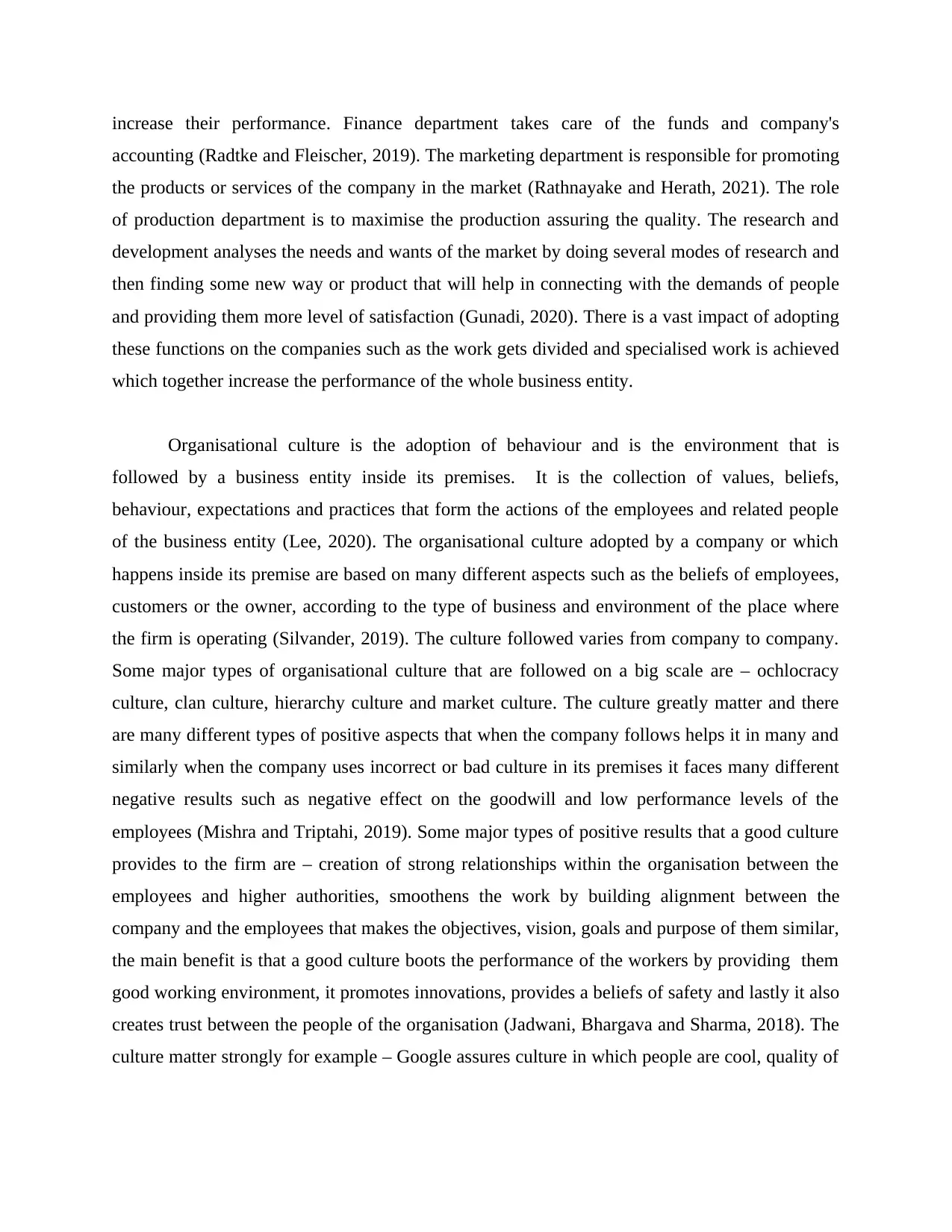
increase their performance. Finance department takes care of the funds and company's
accounting (Radtke and Fleischer, 2019). The marketing department is responsible for promoting
the products or services of the company in the market (Rathnayake and Herath, 2021). The role
of production department is to maximise the production assuring the quality. The research and
development analyses the needs and wants of the market by doing several modes of research and
then finding some new way or product that will help in connecting with the demands of people
and providing them more level of satisfaction (Gunadi, 2020). There is a vast impact of adopting
these functions on the companies such as the work gets divided and specialised work is achieved
which together increase the performance of the whole business entity.
Organisational culture is the adoption of behaviour and is the environment that is
followed by a business entity inside its premises. It is the collection of values, beliefs,
behaviour, expectations and practices that form the actions of the employees and related people
of the business entity (Lee, 2020). The organisational culture adopted by a company or which
happens inside its premise are based on many different aspects such as the beliefs of employees,
customers or the owner, according to the type of business and environment of the place where
the firm is operating (Silvander, 2019). The culture followed varies from company to company.
Some major types of organisational culture that are followed on a big scale are – ochlocracy
culture, clan culture, hierarchy culture and market culture. The culture greatly matter and there
are many different types of positive aspects that when the company follows helps it in many and
similarly when the company uses incorrect or bad culture in its premises it faces many different
negative results such as negative effect on the goodwill and low performance levels of the
employees (Mishra and Triptahi, 2019). Some major types of positive results that a good culture
provides to the firm are – creation of strong relationships within the organisation between the
employees and higher authorities, smoothens the work by building alignment between the
company and the employees that makes the objectives, vision, goals and purpose of them similar,
the main benefit is that a good culture boots the performance of the workers by providing them
good working environment, it promotes innovations, provides a beliefs of safety and lastly it also
creates trust between the people of the organisation (Jadwani, Bhargava and Sharma, 2018). The
culture matter strongly for example – Google assures culture in which people are cool, quality of
accounting (Radtke and Fleischer, 2019). The marketing department is responsible for promoting
the products or services of the company in the market (Rathnayake and Herath, 2021). The role
of production department is to maximise the production assuring the quality. The research and
development analyses the needs and wants of the market by doing several modes of research and
then finding some new way or product that will help in connecting with the demands of people
and providing them more level of satisfaction (Gunadi, 2020). There is a vast impact of adopting
these functions on the companies such as the work gets divided and specialised work is achieved
which together increase the performance of the whole business entity.
Organisational culture is the adoption of behaviour and is the environment that is
followed by a business entity inside its premises. It is the collection of values, beliefs,
behaviour, expectations and practices that form the actions of the employees and related people
of the business entity (Lee, 2020). The organisational culture adopted by a company or which
happens inside its premise are based on many different aspects such as the beliefs of employees,
customers or the owner, according to the type of business and environment of the place where
the firm is operating (Silvander, 2019). The culture followed varies from company to company.
Some major types of organisational culture that are followed on a big scale are – ochlocracy
culture, clan culture, hierarchy culture and market culture. The culture greatly matter and there
are many different types of positive aspects that when the company follows helps it in many and
similarly when the company uses incorrect or bad culture in its premises it faces many different
negative results such as negative effect on the goodwill and low performance levels of the
employees (Mishra and Triptahi, 2019). Some major types of positive results that a good culture
provides to the firm are – creation of strong relationships within the organisation between the
employees and higher authorities, smoothens the work by building alignment between the
company and the employees that makes the objectives, vision, goals and purpose of them similar,
the main benefit is that a good culture boots the performance of the workers by providing them
good working environment, it promotes innovations, provides a beliefs of safety and lastly it also
creates trust between the people of the organisation (Jadwani, Bhargava and Sharma, 2018). The
culture matter strongly for example – Google assures culture in which people are cool, quality of
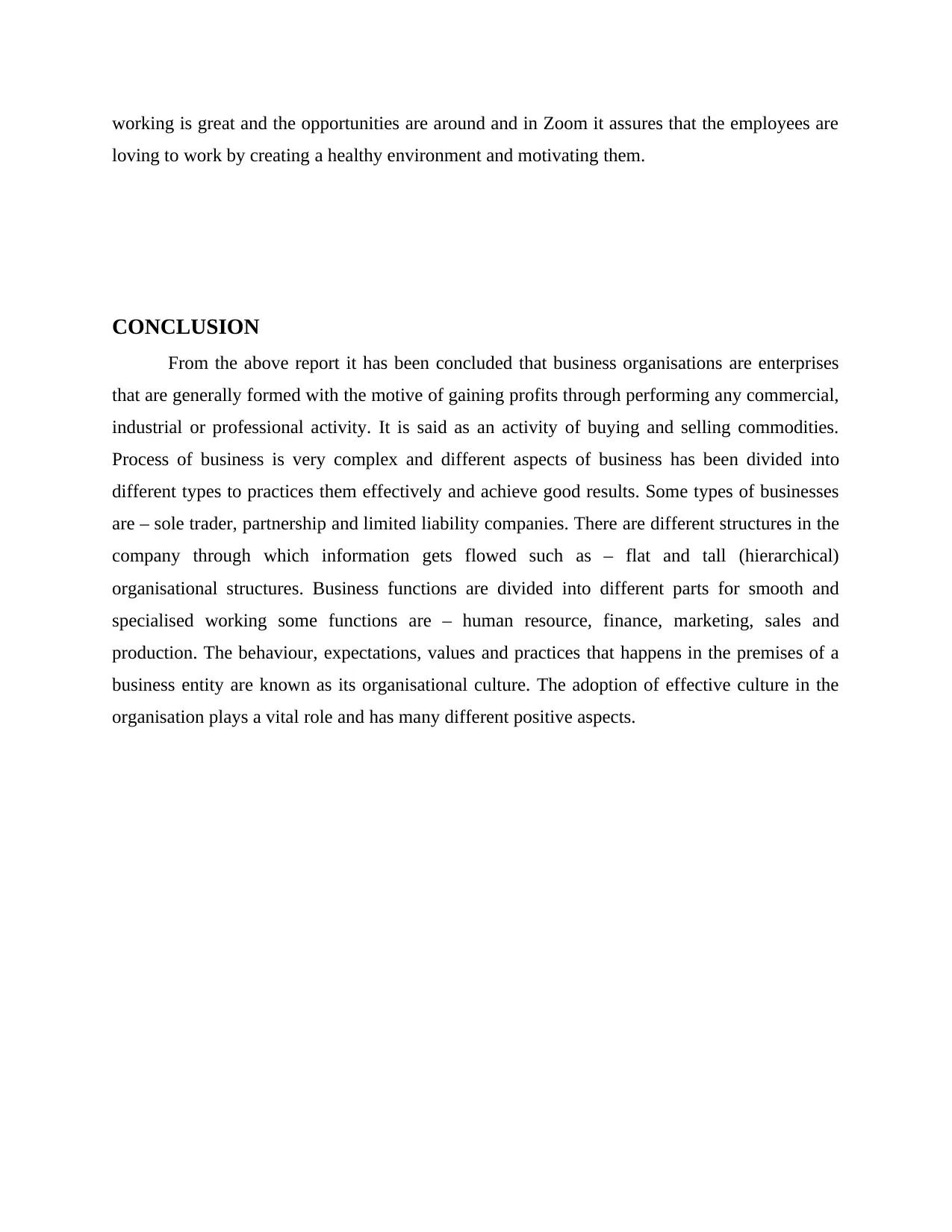
working is great and the opportunities are around and in Zoom it assures that the employees are
loving to work by creating a healthy environment and motivating them.
CONCLUSION
From the above report it has been concluded that business organisations are enterprises
that are generally formed with the motive of gaining profits through performing any commercial,
industrial or professional activity. It is said as an activity of buying and selling commodities.
Process of business is very complex and different aspects of business has been divided into
different types to practices them effectively and achieve good results. Some types of businesses
are – sole trader, partnership and limited liability companies. There are different structures in the
company through which information gets flowed such as – flat and tall (hierarchical)
organisational structures. Business functions are divided into different parts for smooth and
specialised working some functions are – human resource, finance, marketing, sales and
production. The behaviour, expectations, values and practices that happens in the premises of a
business entity are known as its organisational culture. The adoption of effective culture in the
organisation plays a vital role and has many different positive aspects.
loving to work by creating a healthy environment and motivating them.
CONCLUSION
From the above report it has been concluded that business organisations are enterprises
that are generally formed with the motive of gaining profits through performing any commercial,
industrial or professional activity. It is said as an activity of buying and selling commodities.
Process of business is very complex and different aspects of business has been divided into
different types to practices them effectively and achieve good results. Some types of businesses
are – sole trader, partnership and limited liability companies. There are different structures in the
company through which information gets flowed such as – flat and tall (hierarchical)
organisational structures. Business functions are divided into different parts for smooth and
specialised working some functions are – human resource, finance, marketing, sales and
production. The behaviour, expectations, values and practices that happens in the premises of a
business entity are known as its organisational culture. The adoption of effective culture in the
organisation plays a vital role and has many different positive aspects.
⊘ This is a preview!⊘
Do you want full access?
Subscribe today to unlock all pages.

Trusted by 1+ million students worldwide
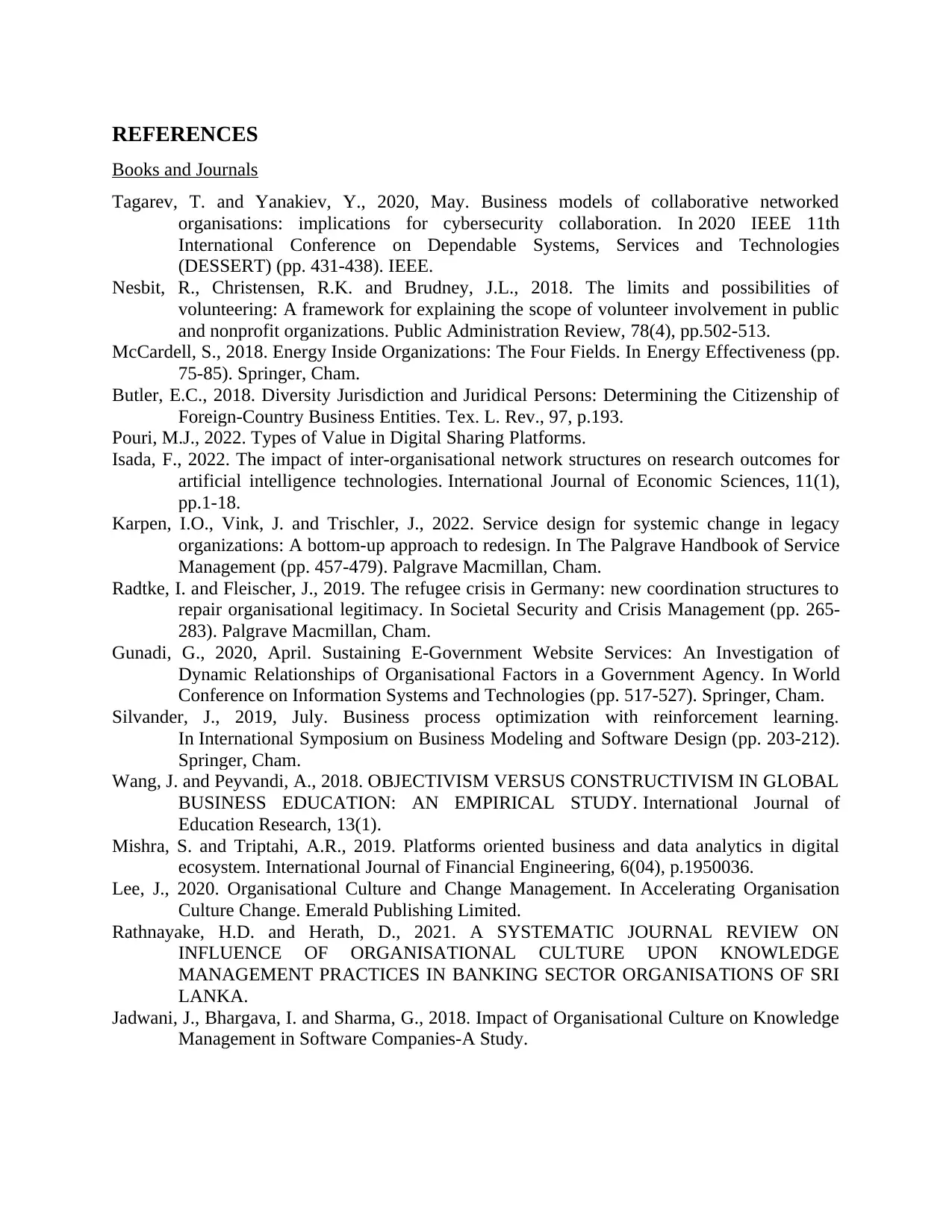
REFERENCES
Books and Journals
Tagarev, T. and Yanakiev, Y., 2020, May. Business models of collaborative networked
organisations: implications for cybersecurity collaboration. In 2020 IEEE 11th
International Conference on Dependable Systems, Services and Technologies
(DESSERT) (pp. 431-438). IEEE.
Nesbit, R., Christensen, R.K. and Brudney, J.L., 2018. The limits and possibilities of
volunteering: A framework for explaining the scope of volunteer involvement in public
and nonprofit organizations. Public Administration Review, 78(4), pp.502-513.
McCardell, S., 2018. Energy Inside Organizations: The Four Fields. In Energy Effectiveness (pp.
75-85). Springer, Cham.
Butler, E.C., 2018. Diversity Jurisdiction and Juridical Persons: Determining the Citizenship of
Foreign-Country Business Entities. Tex. L. Rev., 97, p.193.
Pouri, M.J., 2022. Types of Value in Digital Sharing Platforms.
Isada, F., 2022. The impact of inter-organisational network structures on research outcomes for
artificial intelligence technologies. International Journal of Economic Sciences, 11(1),
pp.1-18.
Karpen, I.O., Vink, J. and Trischler, J., 2022. Service design for systemic change in legacy
organizations: A bottom-up approach to redesign. In The Palgrave Handbook of Service
Management (pp. 457-479). Palgrave Macmillan, Cham.
Radtke, I. and Fleischer, J., 2019. The refugee crisis in Germany: new coordination structures to
repair organisational legitimacy. In Societal Security and Crisis Management (pp. 265-
283). Palgrave Macmillan, Cham.
Gunadi, G., 2020, April. Sustaining E-Government Website Services: An Investigation of
Dynamic Relationships of Organisational Factors in a Government Agency. In World
Conference on Information Systems and Technologies (pp. 517-527). Springer, Cham.
Silvander, J., 2019, July. Business process optimization with reinforcement learning.
In International Symposium on Business Modeling and Software Design (pp. 203-212).
Springer, Cham.
Wang, J. and Peyvandi, A., 2018. OBJECTIVISM VERSUS CONSTRUCTIVISM IN GLOBAL
BUSINESS EDUCATION: AN EMPIRICAL STUDY. International Journal of
Education Research, 13(1).
Mishra, S. and Triptahi, A.R., 2019. Platforms oriented business and data analytics in digital
ecosystem. International Journal of Financial Engineering, 6(04), p.1950036.
Lee, J., 2020. Organisational Culture and Change Management. In Accelerating Organisation
Culture Change. Emerald Publishing Limited.
Rathnayake, H.D. and Herath, D., 2021. A SYSTEMATIC JOURNAL REVIEW ON
INFLUENCE OF ORGANISATIONAL CULTURE UPON KNOWLEDGE
MANAGEMENT PRACTICES IN BANKING SECTOR ORGANISATIONS OF SRI
LANKA.
Jadwani, J., Bhargava, I. and Sharma, G., 2018. Impact of Organisational Culture on Knowledge
Management in Software Companies-A Study.
Books and Journals
Tagarev, T. and Yanakiev, Y., 2020, May. Business models of collaborative networked
organisations: implications for cybersecurity collaboration. In 2020 IEEE 11th
International Conference on Dependable Systems, Services and Technologies
(DESSERT) (pp. 431-438). IEEE.
Nesbit, R., Christensen, R.K. and Brudney, J.L., 2018. The limits and possibilities of
volunteering: A framework for explaining the scope of volunteer involvement in public
and nonprofit organizations. Public Administration Review, 78(4), pp.502-513.
McCardell, S., 2018. Energy Inside Organizations: The Four Fields. In Energy Effectiveness (pp.
75-85). Springer, Cham.
Butler, E.C., 2018. Diversity Jurisdiction and Juridical Persons: Determining the Citizenship of
Foreign-Country Business Entities. Tex. L. Rev., 97, p.193.
Pouri, M.J., 2022. Types of Value in Digital Sharing Platforms.
Isada, F., 2022. The impact of inter-organisational network structures on research outcomes for
artificial intelligence technologies. International Journal of Economic Sciences, 11(1),
pp.1-18.
Karpen, I.O., Vink, J. and Trischler, J., 2022. Service design for systemic change in legacy
organizations: A bottom-up approach to redesign. In The Palgrave Handbook of Service
Management (pp. 457-479). Palgrave Macmillan, Cham.
Radtke, I. and Fleischer, J., 2019. The refugee crisis in Germany: new coordination structures to
repair organisational legitimacy. In Societal Security and Crisis Management (pp. 265-
283). Palgrave Macmillan, Cham.
Gunadi, G., 2020, April. Sustaining E-Government Website Services: An Investigation of
Dynamic Relationships of Organisational Factors in a Government Agency. In World
Conference on Information Systems and Technologies (pp. 517-527). Springer, Cham.
Silvander, J., 2019, July. Business process optimization with reinforcement learning.
In International Symposium on Business Modeling and Software Design (pp. 203-212).
Springer, Cham.
Wang, J. and Peyvandi, A., 2018. OBJECTIVISM VERSUS CONSTRUCTIVISM IN GLOBAL
BUSINESS EDUCATION: AN EMPIRICAL STUDY. International Journal of
Education Research, 13(1).
Mishra, S. and Triptahi, A.R., 2019. Platforms oriented business and data analytics in digital
ecosystem. International Journal of Financial Engineering, 6(04), p.1950036.
Lee, J., 2020. Organisational Culture and Change Management. In Accelerating Organisation
Culture Change. Emerald Publishing Limited.
Rathnayake, H.D. and Herath, D., 2021. A SYSTEMATIC JOURNAL REVIEW ON
INFLUENCE OF ORGANISATIONAL CULTURE UPON KNOWLEDGE
MANAGEMENT PRACTICES IN BANKING SECTOR ORGANISATIONS OF SRI
LANKA.
Jadwani, J., Bhargava, I. and Sharma, G., 2018. Impact of Organisational Culture on Knowledge
Management in Software Companies-A Study.
1 out of 7
Related Documents
Your All-in-One AI-Powered Toolkit for Academic Success.
+13062052269
info@desklib.com
Available 24*7 on WhatsApp / Email
![[object Object]](/_next/static/media/star-bottom.7253800d.svg)
Unlock your academic potential
Copyright © 2020–2025 A2Z Services. All Rights Reserved. Developed and managed by ZUCOL.


